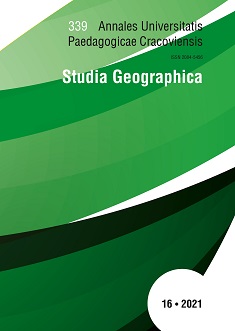Spatial analysis of social vulnerability in health in the Mexican South Pacific region
DOI:
https://doi.org/10.24917/20845456.16.1Abstrakt
This article reflects on the current context of social and health vulnerability, which has become a central issue in government agendas at all levels. They represent social, economic, environmental and health processes that generate a mixed exposure of the territory and the people who inhabit it, making some more vulnerable than others; on the other hand, these conditions are also reflected in the response capacity of each individual, household and society. The objective of this research is to determine the social vulnerability in health in the Mexican South Pacific region, using the official data from the Population and Housing Census of 2020, disaggregated at the municipal level. The variables or socio-spatial conditioning factors of health have been selected, which have been standardized using an omega index to obtain a synthesis indicator of all the variables used, applying a multivariate analysis technique called Spatial Classification Scores (SCS). It allows carrying out an integration of the variables used in a systematic way, which allows a better evaluation and understanding to identify areas with greater or lesser vulnerability. The Mexican South Pacific region is a territory of great diversity and complexity, both in the social as well as in the economic and geographical context, which is why at the national level is the region with the greatest social backwardness and with the worst health rates. The results show that the highest vulnerability values are located in Cochoapa el Grande, Metlatónoc (Guerrero) and San Simón Zahuatlán (Oaxaca), characterized by high deficiencies in health services, education, decent housing and employment.
Bibliografia
Buzai, G. (2014). Mapas Sociales Urbanos. Argentina: Lugar Editorial.
Buzai, G.D., Santana, M.V. (2018). Condicionantes Socioespaciales de la Salud (CSS): Bases y alcance conceptual. Anuario de la División Geografía. Universidad Nacional de Luján. N° 12, 157-171.
Blaikie, P., Cannon, T., Davis I., Wisner, B. (1994). At Risk. Natural Hazards, People’s Vulnerability and Disasters. London: Routledge.
Cannon, T. (1991). A Hazard Need Not a Disaster Make: Rural Vulnerability and the Causes of Natural Disaster. Ponencia presentada en la Conferencia: Disasters: Vulnerability and Response, DARG/IBG/RGS, London.
Castro, J. (2011). Promoción de la salud. In: R. Gonzáles., J, Castro., L. Moreno (eds.) Promoción de la salud en el ciclo de vida. Ciudad de México: MacGraw-Hill Interamericana.
Cordero, R. y Murayama C. (2012). Los determinantes sociales de la salud en México. Ciudad de México: Fondo de Cultura Económica.
Curto, S. (2003). Mapas en Geografía Médica. Cuaderno Prudentino de Geografía, núm. 25, Brasil: Asociación de geógrafos brasileños, 111-129.
Cutter, S.L., Finch, C. (2008). Temporal and spatial changes in social vulnerability to natural hazards. P. Natl. Acad. Sci. USA, 105, 2301-2306.
Dubos, R. (1975). El espejismo de la salud. Ciudad de México: Fondo de Cultura Económica.
Fenk, J. (1977). René Dubos: hacia una nueva medicina. Revista de la Universidad de México, No. 7, 44-45.
Godínez, V., Burns, R. (2012). Desarrollo regional y salud. In: R. Cordero., C. Murayama (eds.) Los determinantes sociales de la salud en México. Ciudad de México: Fondo de Cultura Económica, 168-243.
Juárez, C., Márquez, M., Salgado, N., Pelcastre, B., Ruelas, Ma. G., Reyes, H. (2014). La desigualdad en salud de grupos vulnerables de México: adultos mayores, indígenas y migrantes. Rev Panam Salud Pública, 35(4), 284-90.
Herrero, S. (2018). ¿Cómo son las comunidades marginales que generan pobreza estructural? Papeles de Población, vol. 24, núm. 98, 157-172. DOI: doi.org/10.22185/24487147.201 8.98.39
Hewitt, K. (1983). Interpretations of Calamity, from the Viewpoint of Human Ecology. New York: Allen and Unwin.
INEGI (Instituto Nacional de Estadística y Geografía). (2020). Censo de población y vivienda 2020. INEGI, México. Obtenido de: https://www.inegi.org.mx/programas/ccpv/2020/.
INEGI (Instituto Nacional de Estadística y Geografía) (2019). Encuesta Nacional de Ocupación y Empleo (ENOE), 2019. INEGI, México. Obtenido de: https://www.inegi.org.mx/temas/empleo/#Tabulados
Maskrey, A. (1993). Los desastres no son naturales. Colombia: La Red.
Moser, C. (1998). Reassessing Urban Poverty Reduction Strategies: The Asset Vulnerability Framework. World Development, Vol. 26. N° 1. Washington DC: The World Bank, 1-19.
Organización Panamericana de la Salud (OPS). (2012). Declaración de Alma-Ata, Kazajistán.
Organización Panamericana de la Salud. Recuperado de: https://www.paho.org/es/alma-ata.
Pizarro, R. (2001). La vulnerabilidad social y sus desafíos: una mirada desde América Latina.
Serie Estudios Estadísticos, No.6 CEPAL. Santiago de Chile: Naciones Unidas. Recuperado de: https://repositorio.cepal.org/bitstream/handle/11362/4762/S0102116_es.pdf.
Secretaria de Salud (SS). (2020). Dirección General de Información en Salud. SS, México. Obtenido de: https://www.gob.mx/salud/acciones-y-programas/direccion-general-de-informacion-en-salud-dgis
Solar, O., Irwin A. (2007). A conceptual framework for action on the social determinants of health. Social determinants of health discussion. Paper N° 2. Ginebra, Suiza: WHO. Obtained from: http://www.who.int/sdhconference/resources/ConceptualframeworkforactiononSDHeng.pf
Welti, C. (2012). Transición demográfica y salud en México. En: R. Cordero., C. Murayama (eds.) Los determinantes sociales de la salud en México. Ciudad de México: Fondo de Cultura Económica, 63-117.
White, G. (1974). Natural Hazards: Local, National, Global. Oxford: Oxford University Press.
Wilches-Chaux, G. (1993). La vulnerabilidad global. En: A. Maskrey (ed.) Los desastres no son naturales. Colombia: La Red, 9-50.
World Health Organization (WHO). (2010). Declaración de Adelaida sobre la salud en todas las políticas. Hacia una gobernanza compartida en pro de la salud y el bienestar. Organización Mundial de la Salud. Recuperado de: http://www.who.int/social_determinants/spanish_adelaide_statement_for_web.pdf
World Health Organization (WHO). (2009). Subsanar las desigualdades en una generación. Alcanzar la equidad sanitaria actuando sobre los determinantes sociales de la salud. Informe final de la Comisión sobre Determinantes Sociales de la Salud. Organización Mundial de la Salud. Recuperado de http://www.who.int/social_determinants/thecommission/finalreport/es/
Pobrania
Opublikowane
Numer
Dział
Licencja
Złożenie artykułu do druku oznacza wyrażenie zgody na bezpłatne (tj. bez honorariów autorskich) przeniesienie autorskich praw majątkowych na Wydawcę i zezwolenie na wydanie pracy w postaci drukowanej w dowolnej liczbie egzemplarzy oraz zamieszczenie jej w postaci otwartego dostępu na stronie internetowej czasopisma, w bibliotekach cyfrowych oraz innych cyfrowych platformach wydawniczych, z którymi Wydawca zawarł lub zawrze stosowne porozumienie o udostępnianiu. W przypadku artykułów wieloautorskich przyjmuje się, że autor zgłaszający pracę („correspondingauthor”) ma pełnomocnictwo do reprezentowania pozostałych współautorów w tym zakresie. Autorzy są proszeni o podpisanie stosownego oświadczenia w tej sprawie.

